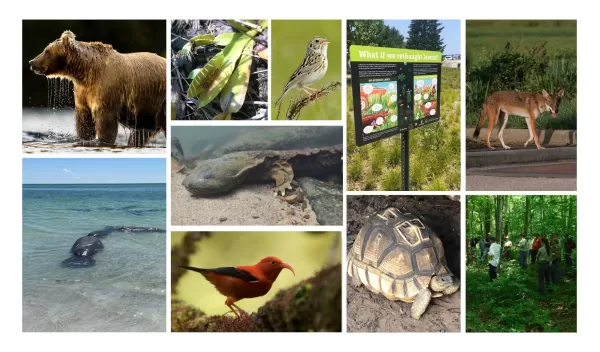
U.S. National Science Foundation, Paul G. Allen Family Foundation double investment in science-driven conservation projects
The U.S. National Science Foundation and the Paul G. Allen Family Foundation are investing $16 million across 10 projects that will conduct basic science with direct conservation applications to benefit species and ecosystems. The projects are awarded under the second year of grants from the Partnership to Advance Conservation Science and Practice (PACSP) program, a first-of-its-kind collaboration between the two funders designed to catalyze deep collaboration between researchers advancing basic science and conservation partners engaging in on-the-ground conservation.
Each project extends basic science into on-the-ground conservation to address critical knowledge and data gaps, enabling greater real-world impact. The projects focus on a range of species – from grizzly bears and manatees to Venus flytraps and Hawaiian honeycreepers – and the outcomes will have far-reaching implications for biodiversity and conservation, policy and the economy.
"The fundamental knowledge these projects create, even though related to specific species, will unlock innovative conservation efforts across a broader range of threatened species and ecosystems," said Lara Littlefield, executive director for programs and partnerships at the Paul G. Allen Family Foundation. "For instance, studying whether some microorganisms in mosquitoes can help limit the spread of malaria among birds in Hawaii could ultimately limit disease spread among other animals more broadly."
In addition to supporting research, this year's PACSP solicitation includes a TOOLS track to support the creation of new technologies for conservation or new applications of existing technologies in conservation. Nearly half of the funded projects were submitted under this track and include the use of artificial intelligence, genotyping and species identification.
"The unique partnerships this program creates forge a roadmap to broader conservation action by uniting the skills, expertise and tools needed to address the most urgent threats to our natural world," said Susan Marqusee, NSF assistant director for biological sciences. "These projects also will engage the public, policymakers, law enforcement and others in conservation through education, outreach and other broader impacts."
The following list describes each project and primary grantees with links to full project summaries:
- Reducing avian malaria transmission to Hawaiian Honeycreepers with mosquito-associated microbes — University of Hawaii, Hawaii Department of Land and Natural Resources.
- Improving forest fire management through study of Venus Flytrap as indicator species — Kansas State University, Duke University, North Carolina Botanical Garden.
- Creating a model to monitor long-term impacts of conservation actions on the genetic diversity of grizzly bear populations — UC Santa Cruz, UC Riverside, University of Montana, U.S. Fish and Wildlife Service, U.S. Geological Survey.
- Disrupting illegal wildlife trade by enabling molecular identification of sharks, rays, and turtles — Worcester Polytechnic Institute, Florida International University, University of Maryland.
- Modeling ghost genes (genetic material historically transferred from extinct or nearly extinct species to living ones) of Gulf Coast canids — Princeton University, Michigan Technological University, Mississippi State University, Endangered Wolf Center.
- Restoring habitat of grassland birds through development of Integrated Population Model using data from breeding and non-breeding grounds of three declining species — Colorado State University, Bird Conservancy of the Rockies.
- Converting urban turf lawns to native plants to bolster ecosystem services and understand conservation potential — Chicago Horticultural Society, Chicago Park District.
- Conserving stream biodiversity by studying the impact of climate and land use changes on the imperiled eastern hellbender, an Appalachian salamander species sensitive to low dissolved oxygen levels — Virginia Tech, Virginia Department of Wildlife Resources.
- Developing AI for cost-effective wildlife identification, tracking, and behavior analysis for marine animals through study on manatees — Florida Atlantic University, Old Dominion University, Mote Marine Laboratory.
- Using big data about the ecology of the Appalachian Mountains to co-develop migratory bird conservation efforts with landowners and land managers to balance habitat needs with community objectives — University of Maryland Center for Environmental Science, American Bird Conservancy.
About U.S. National Science Foundation
The U.S. National Science Foundation propels the nation forward by advancing fundamental research in all fields of science and engineering. NSF supports research and people by providing facilities, instruments and funding to support their ingenuity and sustain the U.S. as a global leader in research and innovation. With a Fiscal Year 2024 budget of $9.06 billion, NSF funds reach all 50 states through grants to nearly 2,000 colleges, universities and institutions. Each year, NSF receives more than 40,000 competitive proposals and makes about 11,000 new awards. Those awards include support for cooperative research with industry, Arctic and Antarctic research and operations, and U.S. participation in international scientific efforts.
About Paul G. Allen Family Foundation
Founded in 1988 by philanthropists Jody Allen and the late Paul G. Allen, co-founder of Microsoft, the foundation works to enhance the arts and culture experience, mobilize young people to drive change, and advance science and technology solutions that address wildlife conservation, ocean health and climate change. The foundation also funds cutting-edge research in all areas of bioscience though the Paul G. Allen Frontiers Group.
